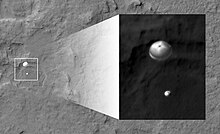
Mars atmospheric entry
Mars atmospheric entry is the entry into the atmosphere of Mars . High velocity entry into Martian air creates a CO 2 -N 2 plasma, as opposed to O 2 -N 2 for Earth air. [1] Mars entry is affected by the radiative effects of hot CO 2 gas and Martian dust suspended in the air. [2] Flight regimes for entry, descent, and landing systems include aerocapture, hypersonic, supersonic, and subsonic. [3]
Page Revisions
| Year | Metadata | Sections | Top Words | First Paragraph |
| 2018 |
51955 characters 10 sections 12 paragraphs 11 images 49 internal links 19 external links |
entry 0.442 isotensoid 0.248 retropropulsion 0.248 descent 0.183 cone 0.173 landing 0.160 tension 0.153 retropropulsive 0.140 velocity 0.139 supersonic 0.133 spacex 0.133 fence 0.128 aerocapture 0.128 torus 0.112 stacked 0.105 |
Mars atmospheric entry is the entry into the atmosphere of Mars . High velocity entry into Martian air creates a CO 2 -N 2 plasma, as opposed to O 2 -N 2 for Earth air. [1] Mars entry is affected by the radiative effects of hot CO 2 gas and Martian dust suspended in the air. [2] Flight regimes for entry, descent, and landing systems include aerocapture, hypersonic, supersonic, and subsonic. [3] |
|
| 2017 |
37197 characters 9 sections 10 paragraphs 8 images 42 internal links 13 external links |
entry 0.465 isotensoid 0.260 retropropulsion 0.260 descent 0.192 cone 0.182 tension 0.161 supersonic 0.139 fence 0.134 aerocapture 0.134 landing 0.131 torus 0.117 velocity 0.117 stacked 0.111 parachute 0.109 n2 0.107 |
Mars atmospheric entry is the entry into the atmosphere of Mars . High velocity entry into Martian air creates a CO 2 -N 2 plasma, as opposed to O 2 -N 2 for Earth air. [1] Mars entry is affected by the radiative effects of hot CO 2 gas and Martian dust suspended in the air. [2] Flight regimes for entry, descent, and landing systems include aerocapture, hypersonic, supersonic, and subsonic. [3] |
|
| 2016 |
36340 characters 7 sections 10 paragraphs 8 images 42 internal links 13 external links |
entry 0.465 isotensoid 0.260 retropropulsion 0.260 descent 0.192 cone 0.182 tension 0.161 supersonic 0.139 fence 0.134 aerocapture 0.134 landing 0.131 torus 0.117 velocity 0.117 stacked 0.111 parachute 0.109 n2 0.107 |
Mars atmospheric entry is the entry into the atmosphere of Mars . High velocity entry into Martian air creates a CO 2 -N 2 plasma, as opposed to O 2 -N 2 for Earth air. [1] Mars entry is affected by the radiative effects of hot CO 2 gas and Martian dust suspended in the air. [2] Flight regimes for entry, descent, and landing systems include aerocapture, hypersonic, supersonic, and subsonic. [3] |
|
| 2015 |
34376 characters 6 sections 9 paragraphs 6 images 39 internal links 12 external links |
entry 0.464 isotensoid 0.260 retropropulsion 0.260 descent 0.192 cone 0.182 tension 0.161 supersonic 0.139 fence 0.134 aerocapture 0.134 landing 0.131 torus 0.117 velocity 0.117 stacked 0.111 parachute 0.109 n2 0.107 |
Mars atmospheric entry is the entry into the atmosphere of Mars . High velocity entry into Martian air creates a CO 2 -N 2 plasma, as opposed to O 2 -N 2 for Earth air. [1] Mars entry is effected by the radiative effects of hot CO 2 gas and Martian dust suspended in the air. [2] Flight regimes for entry, descent, and landing systems include aerocapture, hypersonic, supersonic, and subsonic. [3] |
|
| 2014 |
34268 characters 6 sections 9 paragraphs 6 images 38 internal links 12 external links |
entry 0.464 isotensoid 0.260 retropropulsion 0.260 descent 0.192 cone 0.182 tension 0.161 supersonic 0.139 fence 0.134 aerocapture 0.134 landing 0.131 torus 0.117 velocity 0.117 stacked 0.111 parachute 0.109 n2 0.107 |
Mars atmospheric entry is the entry into the atmosphere of Mars . High velocity entry into Martian air creates a CO 2 -N 2 plasma, as opposed to O 2 -N 2 for Earth air. [1] Mars entry is effected by the radiative effects of hot CO 2 gas and Martian dust suspended in the air. [2] Flight regimes for entry, descent, and landing systems include aerocapture, hypersonic, supersonic, and subsonic. [3] |
|
| 2013 |
20181 characters 6 sections 7 paragraphs 6 images 27 internal links 11 external links |
entry 0.427 isotensoid 0.326 cone 0.229 tension 0.202 fence 0.168 aerocapture 0.168 torus 0.147 stacked 0.139 parachute 0.137 n2 0.134 inflatable 0.133 timeline 0.124 descent 0.120 air 0.120 supersonic 0.116 |
Mars atmospheric entry is the entry into the atmosphere of Mars . High velocity entry into Martian air creates a CO 2 -N 2 plasma, as opposed to O 2 -N 2 for Earth air. [1] Mars entry is effected by the radiative effects of hot CO 2 gas and Martian dust suspended in the air. [2] Flight regimes for entry, descent, and landing systems include aerocapture, hypersonic, supersonic, and subsonic. [3] |
|
| 2012 |
18338 characters 6 sections 7 paragraphs 5 images 24 internal links 10 external links |
entry 0.427 isotensoid 0.326 cone 0.229 tension 0.202 fence 0.168 aerocapture 0.168 torus 0.147 stacked 0.139 parachute 0.137 n2 0.134 inflatable 0.133 timeline 0.124 descent 0.120 air 0.120 supersonic 0.116 |
Mars atmospheric entry is the entry into the atmosphere of Mars . High velocity entry into Martian air creates a CO 2 -N 2 plasma, as opposed to O 2 -N 2 for Earth air. [1] Mars entry is effected by the radiative effects of hot CO 2 gas and Martian dust suspended in the air. [2] Flight regimes for entry, descent, and landing systems include aerocapture, hypersonic, supersonic, and subsonic. [3] |